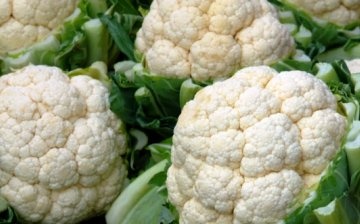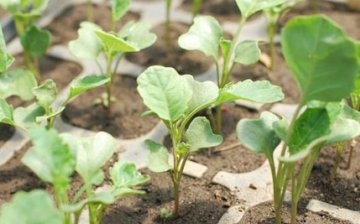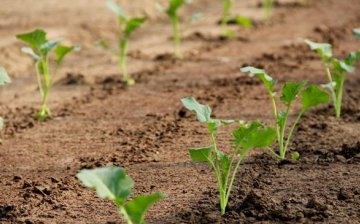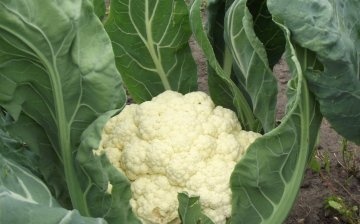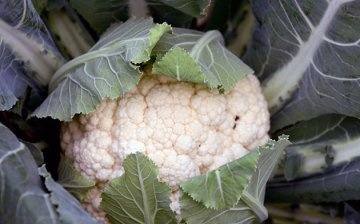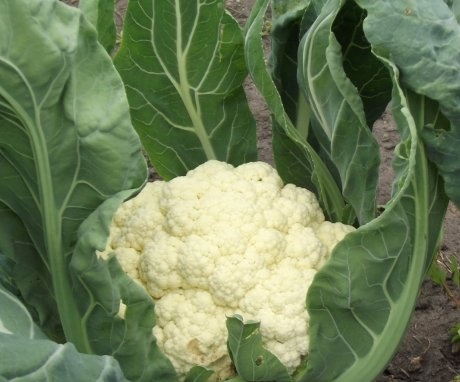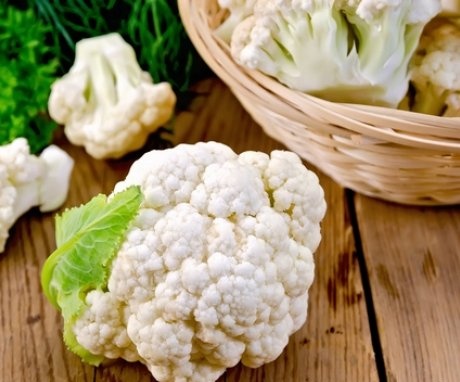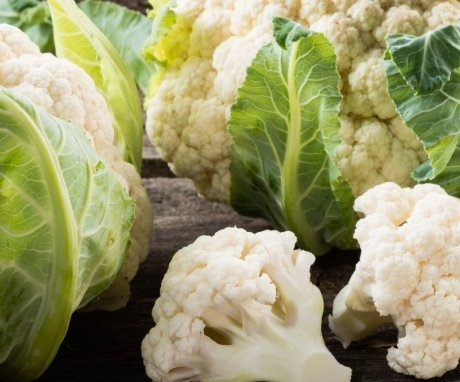Growing cauliflower correctly outdoors
Cauliflower Is an annual plant that has long taken root among vegetable lovers. Peduncles are usually used for food, which can be of various shades: from white to purple. Currently, about 10 different types of cauliflower are known, which are subdivided into early ripening, medium ripening and late.
Early ripening occurs in the period from 80 to 100 days, these include varieties: Snezhinka, Movir, Gribovskaya. Medium ripening varieties require from 90 to 120 days, these include: Moskovskaya and Garantia. Late varieties ripen from 170 to 230 days, these include: Adlerskaya and Sochinskaya. Cauliflower is grown in almost the same way as ordinary white cabbage, however, for a rich harvest, you should know many nuances.
Content:
- How to properly grow seedlings
- Preparation for planting in open ground
- Care Tips
- Fight against major diseases and pests
- Valuable properties and benefits of cauliflower
- The use of cauliflower in traditional medicine recipes
How to properly grow seedlings
The best time to plant seedlings from seeds - end of February for an early variety, mid-March for a medium-ripening variety and end of March for a late variety.
Before planting cauliflower seeds, it is important to prepare:
- They are placed in 50-degree water and steamed for 15 minutes.
- Then the seeds are placed in water at room temperature for 12 hours, and later placed in the refrigerator, on the lower shelf.
- The seeds must spend a day there.
- After that, the seeds are dried and they are ready for planting.
How to sow prepared seeds correctly:
- Several cauliflower seeds are sown in one container.
- Drainage is laid out at the bottom of the container.
- The soil should consist of: four parts of peat, one part of a mullein and ten parts of rotted sawdust. You can also mix another composition of ten parts of humus, one part of peat and sand.
- The soil can be fertilized ash.
- Landing should be done at a depth of 5 mm.
- Next, the soil is tamped.
- Maintain at the level of 18-20 degrees until the first shoots.
- After germination, maintain at a level of 6-8 degrees.
- After a week, maintain at 16-18 degrees during the day and 9-10 at night.
- If the temperature regime is too warm, more than 21 degrees, then the cabbage inflorescences may not form ovaries at all.
Seedling care rules:
- Exercise regular watering.
- Loosen the soil.
- Prophylactically treat the soil with a solution of potassium permanganate.
- When the first two leaves appear, the seedlings are sprayed with a solution of boric acid.
Preparation for planting in open ground
The early variety is to be sown in the ground at the end of April - mid-May. The medium ripening variety can be planted in late May - mid June, and late in late June - mid July. A few days before disembarkation, you need to be in time:
- Feed the seedlings with superphosphates and potassium.
- Carry out hardening of seedlings.
Preparing a site for transplanting seedlings into open ground:
- Land for sowing cabbage should be open and light.
- The soil should be neutral in acidity.
- It is good to plant cabbage, if earlier on the site grew: onion and garlic, carrot and potatoes.
- The soil should be fertilized with humus, superphosphate and urea.
How is the planting of cauliflower seedlings:
- Planting is carried out in warm and humid weather.
- The gap between shoots should be approximately 35 cm.
- The plant is placed in the hole until the first leaves and the soil is tamped.
- Further carried out watering.
- At first, it is better to cover the cabbage with foil overnight.
Care Tips
How to properly care for cauliflower after planting in open ground:
- To carry out regular watering, about seven liters of water will be required per square meter.
- To loosen the soil to a depth of eight centimeters, it is best to do this after watering or rain.
- Apply fertilizers up to 4 times per season, for this it is suitable mullein and mineral fertilizers.
Here are the basic guidelines to follow to harvest a good cauliflower crop. The collection of cauliflower begins when the inflorescences reach 9 cm in diameter, while their weight ranges from three hundred grams to a kilogram.
How to collect cauliflower:
- The inflorescences are cut, leaving at least two leaves on the stem.
- The inflorescences are immediately removed into boxes, which are covered with foil. Do not leave them in the sun, as the cabbage will quickly deteriorate.
- It is important not to allow cabbage to overripe, as it will lose its taste and useful properties.
Cabbage can sit in a cool place for up to two months. You can wash the inflorescences and freeze them fresh or boiled. Cabbage can also be stored by hanging it by the stems, inflorescences down.
Fight against major diseases and pests
Unfortunately, cauliflower is highly susceptible to disease and pest attacks, so controlling them is an integral part of growing them.
The main pests:
- Slugs that can be fought with ash and onion peel decoction.
- Cruciferous fleas, which are fought by neighboring plantings Luke and garlicas well as insecticides.
- Cabbage flies, they can be fought with adjacent plantings celery and watering with a solution from Karbofos.
- Cabbage aphid, you can fight with it with a decoction of hot pepper, tansy, wormwood and mustard.
- Moth cabbage, if you do not use any insecticides, then it is most effective to collect the larvae of this pest by hand.
The main diseases that can affect cauliflower:
- Defeat with Alternaria. Cabbage leaves turn black with spots, as a result of which they dry out. In order to prevent the development of the disease, it is important to disinfect the seeds before planting (for example, sulfur or copper sulfate).
- Keel defeat. The roots of cabbage become covered with bulges, which leads to rotting. Ash and dolomite flour solution helps to fight the disease.
- Spotted lesion. Circles of black dots begin to appear on the leaves, as a result of which the leaf is deformed. The fight against the disease is carried out using fungicides.
- Damage to wet rot. Stems and inflorescences cover dark spots, resulting in rotting. The fight against the disease begins with the complete destruction of diseased plants. As a preventive measure, spraying with colloidal sulfur can be carried out.
- Damage by vascular bacteriosis. Spots form on cabbage leaves, which turn black and begin to rot. To prevent the development of the disease, seeds and soil should be disinfected during planting.
- Defeat with jaundice. The leaves turn yellow, and the veins become darker, as a result of which they fall off. Fight disease with Fundazole. It is also worth disinfecting the irrigation water when using rainwater.
- Defeat powdery mildew... The leaves are covered with spots and white bloom, then the plant begins to dry out.The fight against the disease is carried out with fungicides.
Valuable properties and benefits of cauliflower
Cauliflower can be called a dietary and very healthy product. Its composition is rich in vitamins and valuable microelements. Among them are:
- Vitamins of group B
- Vitamin D
- Vitamin A
- Vitamin K
- Vitamin PP
- Vitamin C (50 grams of cabbage is the daily requirement)
- Trace elements: iron, potassium, calcium, sodium, phosphorus, sulfur, magnesium, etc.
- Biotin
Who is cauliflower good for:
- For diseases of the stomach and gallbladder.
- With high cholesterol.
- For the normalization of the nervous system.
- For the prevention of the appearance of neoplasms.
- With diabetes mellitus.
The composition of cauliflower contains cellulose, which is a mild laxative and delicately cleanses the intestines. The presence of magnesium promotes hematopoiesis and an increase in hemoglobin. Biotin has a general anti-inflammatory effect and also reduces excessive oiliness in the skin.
In addition, cauliflower has a choleretic effect and normalizes the digestive tract.
Consuming cauliflower can be a good prevention during epidemics, due to the rich content of vitamin C. One hundred grams of cauliflower contains only 29 kcal, so it will be an ideal product for people who monitor their diet or want to lose weight. Adherents of proper nutrition have long appreciated the high benefits of cauliflower. You can cook many delicious dishes from it, while not being afraid for your figure.
Who should not eat cauliflower:
- With increased acidity and colic.
- With hypertension.
- With kidney disease.
- With hormonal imbalances, cauliflower does not work well for people who have thyroid problems.
- With gout, since cauliflower contains a considerable amount of purines.
- In case of allergic reactions, which happens extremely rarely.
The use of cauliflower in traditional medicine recipes
In addition to a huge number of useful properties, cauliflower also has some medicinal qualities:
- It is recommended to ferment the cauliflower and consume it before breakfast for constipation.
- Cauliflower juice will help the ulcers heal. Within a month, you should drink half a glass of warmed juice one hour before a meal.
- Cauliflower brine will be useful for hemorrhoids.
- In the presence of burns and purulent wounds, you can make mashed cauliflower leaves by adding egg white there. Compresses are made from this mixture until healing.
- In case of gum disease, rinse your mouth with cauliflower juice diluted with boiled water in a 50:50 ratio.
Cauliflower is worthy of growing on every gardener's plot. After all, caring for it is not difficult, and a large number of useful properties is one of the main advantages of this plant.
More information can be found in the video:



